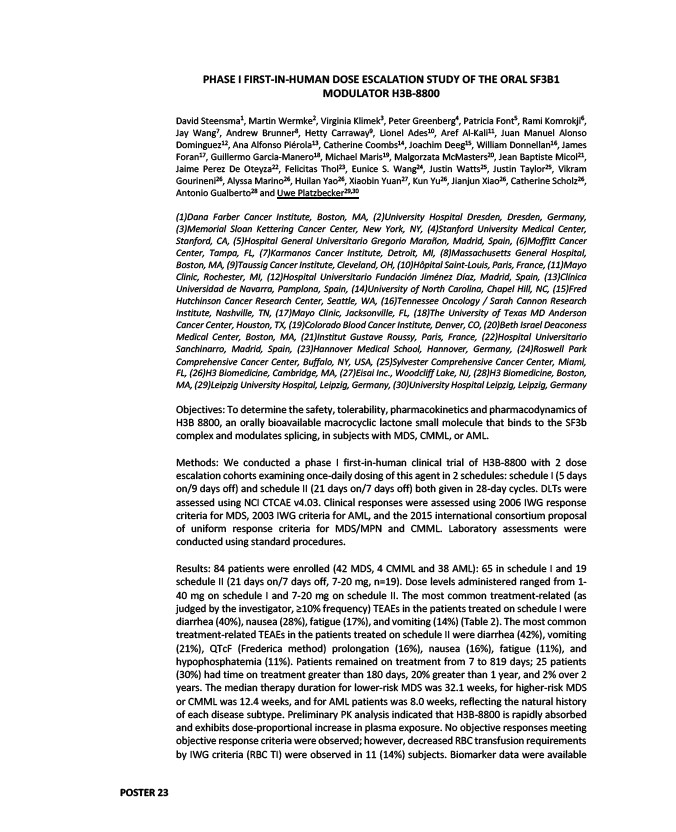
PHASE I FIRST-IN-HUMAN DOSE ESCALATION STUDY OF THE ORAL SF3B1
MODULATOR H3B-8800
David Steensma1, Martin Wermke2, Virginia Klimek3, Peter Greenberg4, Patricia Font5, Rami Komrokji6,
Jay Wang7, Andrew Brunner8, Hetty Carraway9, Lionel Ades10, Aref Al-Kali11, Juan Manuel Alonso
Dominguez12, Ana Alfonso Piérola13, Catherine Coombs14, Joachim Deeg15, William Donnellan16, James
Foran17, Guillermo Garcia-Manero18, Michael Maris19, Malgorzata McMasters20, Jean Baptiste Micol21,
Jaime Perez De Oteyza22, Felicitas Thol23, Eunice S. Wang24, Justin Watts25, Justin Taylor25, Vikram
Gourineni26, Alyssa Marino26, Huilan Yao26, Xiaobin Yuan27, Kun Yu26, Jianjun Xiao26, Catherine Scholz26,
Antonio Gualberto28 and Uwe Platzbecker29,30
(1)Dana Farber Cancer Institute, Boston, MA, (2)University Hospital Dresden, Dresden, Germany,
(3)Memorial Sloan Kettering Cancer Center, New York, NY, (4)Stanford University Medical Center,
Stanford, CA, (5)Hospital General Universitario Gregorio Marañon, Madrid, Spain, (6)Moffitt Cancer
Center, Tampa, FL, (7)Karmanos Cancer Institute, Detroit, MI, (8)Massachusetts General Hospital,
Boston, MA, (9)Taussig Cancer Institute, Cleveland, OH, (10)Hôpital Saint-Louis, Paris, France, (11)Mayo
Clinic, Rochester, MI, (12)Hospital Universitario Fundación Jiménez Díaz, Madrid, Spain, (13)Clínica
Universidad de Navarra, Pamplona, Spain, (14)University of North Carolina, Chapel Hill, NC, (15)Fred
Hutchinson Cancer Research Center, Seattle, WA, (16)Tennessee Oncology / Sarah Cannon Research
Institute, Nashville, TN, (17)Mayo Clinic, Jacksonville, FL, (18)The University of Texas MD Anderson
Cancer Center, Houston, TX, (19)Colorado Blood Cancer Institute, Denver, CO, (20)Beth Israel Deaconess
Medical Center, Boston, MA, (21)Institut Gustave Roussy, Paris, France, (22)Hospital Universitario
Sanchinarro, Madrid, Spain, (23)Hannover Medical School, Hannover, Germany, (24)Roswell Park
Comprehensive Cancer Center, Buffalo, NY, USA, (25)Sylvester Comprehensive Cancer Center, Miami,
FL, (26)H3 Biomedicine, Cambridge, MA, (27)Eisai Inc., Woodcliff Lake, NJ, (28)H3 Biomedicine, Boston,
MA, (29)Leipzig University Hospital, Leipzig, Germany, (30)University Hospital Leipzig, Leipzig, Germany
Objectives: To determine the safety, tolerability, pharmacokinetics and pharmacodynamics of
H3B 8800, an orally bioavailable macrocyclic lactone small molecule that binds to the SF3b
complex and modulates splicing, in subjects with MDS, CMML, or AML.
Methods: We conducted a phase I first-in-human clinical trial of H3B-8800 with 2 dose
escalation cohorts examining once-daily dosing of this agent in 2 schedules: schedule I (5 days
on/9 days off) and schedule II (21 days on/7 days off) both given in 28-day cycles. DLTs were
assessed using NCI CTCAE v4.03. Clinical responses were assessed using 2006 IWG response
criteria for MDS, 2003 IWG criteria for AML, and the 2015 international consortium proposal
of uniform response criteria for MDS/MPN and CMML. Laboratory assessments were
conducted using standard procedures.
Results: 84 patients were enrolled (42 MDS, 4 CMML and 38 AML): 65 in schedule I and 19
schedule II (21 days on/7 days off, 7-20 mg, n=19). Dose levels administered ranged from 1-
40 mg on schedule I and 7-20 mg on schedule II. The most common treatment-related (as
judged by the investigator, ≥10% frequency) TEAEs in the patients treated on schedule I were
diarrhea (40%), nausea (28%), fatigue (17%), and vomiting (14%) (Table 2). The most common
treatment-related TEAEs in the patients treated on schedule II were diarrhea (42%), vomiting
(21%), QTcF (Frederica method) prolongation (16%), nausea (16%), fatigue (11%), and
hypophosphatemia (11%). Patients remained on treatment from 7 to 819 days; 25 patients
(30%) had time on treatment greater than 180 days, 20% greater than 1 year, and 2% over 2
years. The median therapy duration for lower-risk MDS was 32.1 weeks, for higher-risk MDS
or CMML was 12.4 weeks, and for AML patients was 8.0 weeks, reflecting the natural history
of each disease subtype. Preliminary PK analysis indicated that H3B-8800 is rapidly absorbed
and exhibits dose-proportional increase in plasma exposure. No objective responses meeting
objective response criteria were observed; however, decreased RBC transfusion requirements
by IWG criteria (RBC TI) were observed in 11 (14%) subjects. Biomarker data were available
POSTER 23